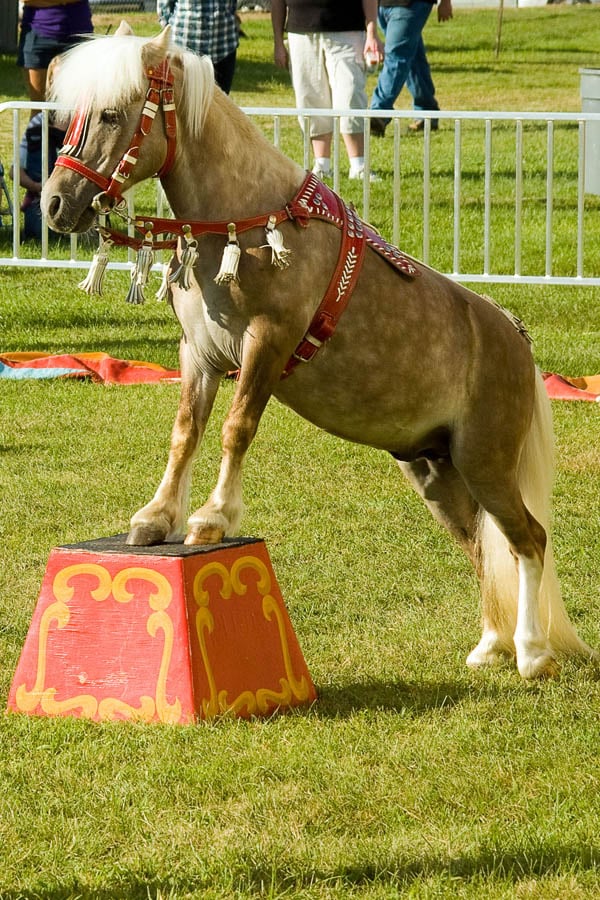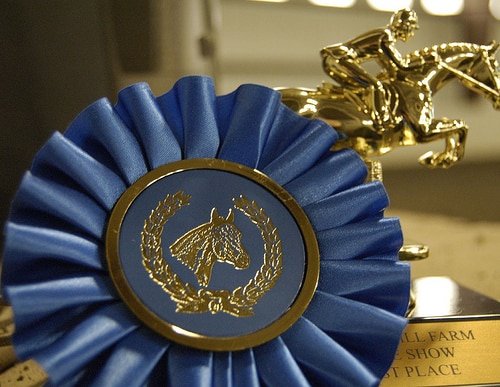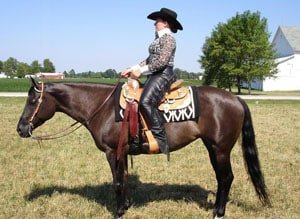
Ranch Versatility has taken the stock horse show circuit by storm, providing a fresh arena for competitors to flock to. Versatility is generally made up of six classes — ranch riding, ranch trail, ranch cutting, ranch reining, ranch cow work and ranch halter (ranch conformation). As the sport of versatility grows, it has become increasingly important to master each class in order to place in the competition as a whole. The single most over-looked class of the lot is halter (conformation). Too many people think it’s easy and try to go into the ring with no preparation only to find out that there is a lot more to halter than a nice rope halter and a well groomed horse.
1. Walk departure
It is important to work on the departures first because good departures build forward momentum through the pattern. Forward momentum is vital for clean, square halts.
If you have a particularly lazy horse, you may need to use a dressage whip or driving whip to extend your reach and allow you to easily cue your horse without moving out of position. Most horses will only need a tap or two before they get the hint and you can stop using the whip.
Just as in showmanship, your toes should be pointed towards the horse’s front feet while in the halt. Turning forward should be a signal to your horse to prepare for a departure. In the show ring, you should only move your feet in preparation for a departure. You should lean forward at the waist just slightly to cue the walk departure, less than you would for a trot departure.
2. Trot departure
There are actually two trot departures – the walk to trot and the halt to trot. The walk to trot is generally going to be used on the initial approach to the judge while the halt to trot will generally be used when moving away from the judge towards the lineup. Both need to be well practiced, but the halt to trot needs to be especially fluid since it will be performed directly in front of the judge in most patterns.
3. Halt and depart again
The halt, of course, is a vital part of the pattern that is too often over-looked. Halts are generally executed directly in front of the judge, so it is important that the halt be crisp and square. The key to getting a square halt is to speed up the horse’s gait just slightly going into the halt. In the beginning you may have to speed up significantly to get that square halt, but you should eventually get to the point where you can cue the slightest speed increase with a subtle cluck or kiss to get a square halt.
This concept actually comes from classical dressage. Rather than trying to mess around with squaring up the legs after a sloppy halt, it is much easier to drive you horse up into the halt – much like driving your horse up into the bit for collection – so that he stops straighter and squarer. With just a little practice you can get nice square halts and greatly increase your ranch halter scores.
4. Stand still
This one may seems a little silly to some people, but standing still is something that most horses actually do need to practice. Too many people go into the class thinking: “Oh, Lucky is a lazy old boy, he’ll stand just fine.” Than they get in there and realize that old Lucky’s version of standing involves cocking a hoof, shifting from side to side, swatting at flies, and standing crooked in ways that make him look horribly out of balance. That is not how you want to present your horse to the judge!
After all your hours of preparation, blood sweat and tears, every point in every class counts. If you want to place in ranch halter, your horse needs to know how to square up and stay where you put him until you tell him to move. So, yes, stand perfectly still takes practice. Start small and work your way up, but it will really pay off in the long run.
5. Standing square
This the actually broken down into 2 parts: square front feet and square back feet. The biggest mistake I see people making is trying to get all 4 feet square at the same time. That’s just too much to learn at once. Remember, you need to break it down into manageable pieces.
Once you’ve managed standing still with all 4 feet planted (in any position), it’s time to work on the front feet. You may need to manually pick the horse’s feet up and place them where you want them. Then ask him to keep them there and reward him with scratches and praise. Don’t ask him to keep them there as long as you practiced standing still. Work back up to that amount of time because you have added another variable.
Once you have mastered the front feet being square, the back feet usually aren’t that hard. Some horses may even square up their back feet automatically to bring their body into balance. If they don’t, just repeat the same process as the front feet.
6. Show halves, not quarters
Unlike showmanship, ranch halter only shows by halves, not quarters. So for anyone who has experience in the showmanship ring, this may take a little pressure off. For those who don’t know what I am talking about, this basically mean you shouldn’t be blocking the judge’s view. When you are in the lineup, keep yourself on the opposite side of the horse from the judge so that he or she has a good view of the horse at all times. Practice smooth transitions from one side of the horse to the other with only 3 steps around the front of the horse to transition from left to right (or vice versa). Always keep the lead in your right hand. Practice smooth side transitions without any movement from your horse so that you don’t loosed that nice square halt that you worked so hard to get.
Polishing for the Ranch Show Pen
Practice, practice, practice. Anything that you expect your horse to do in the show pen should be practiced at home. Don’t just start practicing the night before or even the week before. Give your horse some time to truly learn the concepts and remember that slower really is faster.










So are you saying this is a showmanship class,not a conformation class?